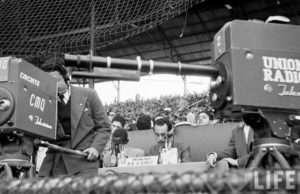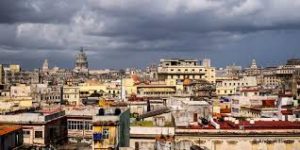LA HABANA DE OTROS TIEMPOS, TAL COMO YO LA RECUERDO. PHOTOS
LA VIDA nocturna habanera era tan rica y variada que hay mucha tela por donde cortar, por lo que voy a referirme a las cosas más usuales que hacían los habaneros, los visitantes y los turistas, cómo pasaban las noches en una velada nocturna típica de La Habana de nuestros recuerdos.
Las opciones eran infinitas e iban desde las más sanas hasta las más deshonestas, había para todos los gustos y para todos los bolsillos, pero voy a referirme a las más aceptadas y concurridas, las más exclusivas y las más populares, pero todas iluminadas por las luces de una ciudad maravillosa.
LOS FANATICOS DEL CINE.
El cine era el entretenimiento mayor en la ciudad con más cines en el mundo entonces. Estaban los estrenos en funciones de gala en los cines de lujo que exhibían las últimas producciones cinematográficas, pero estaban también los numerosos cines de barrio, más modestos y con filmes que ya habían pasado por los circuitos de estreno.
Todos, absolutamente y casi siempre estaban a lleno completo o bien repletos, porque el cine era atractivo y sobre todo muy barato comparado con otros espectáculos. Ya fuera en las funciones de la llamada tanda (en horas de la tarde-noche) o nocturna (a partir de las ocho de la noche) el show siempre estaba disponible y si no se buscaban los cines de exhibición continua, en donde podías entrar en cualquier momento y marcharte cuando desearas, aunque quisieras ver varias veces la misma función.
LA PELOTA.
Otro espectáculo muy gustado era la pelota, o béisbol, que para los cubanos es simplemente “la pelota”. Es mucho más que el deporte nacional, es más que un pasatiempo, es una pasión, por eso nuestro lenguaje está lleno de expresiones beisboleras porque todos tenemos mucho de peloteros y de managers como: “Boto la pelota”, “Lo cogieron fuera de base”, “Batea por las dos bandas”, “Esta arriba de la bola” y muchos otros mas.
Todas con un significado muy claro comparado con las situaciones que se presentan en este deporte, porque recordemos que Cuba era considerada la segunda plaza en importancia de la pelota profesional en el mundo en la década de los 50.
Había cuatro equipos en la Liga Profesional Cubana: Almendares, Habana, Cienfuegos y Marianao. Y no hacían falta más. Todos eran equipos de calidad integrados siempre por los mejores, que casi todos eran también jugadores de equipos de Grandes Ligas y algunos peloteros de otros países, sobre todo americanos, convertidos en ídolos de nuestra pelota junto a los cubanos, como Tom La Sorda y Rocky Nelson, este último una curiosidad y más que ello una leyenda en la pelota cubana, donde mayor éxito tuvo.
Pero existían limitaciones que regían la cantidad de jugadores extranjeros y que solo tuvieran dos años jugando en Grandes Ligas, para garantizar que la inmensa mayoría fueran cubanos.
Sumamos a la lista de los foráneos al gran Willie Mays, el fantástico pitcher Don Newcombe, Sal Maglie, uno que lanzaba sin wind up y al que le decían “el barbero” porque casi afeitaba a los bateadores, Dick Sisler, Solly Drake, Hal Smith, Jim Bunning y “el Diablo” Willie Wells. La Liga de peloteros negros norteamericanos aprovechó la oportunidad y muchos jugaron en Cuba, entre ellos leyendas como Leroy “Satchel” Paige, Roy Campanella, Monte Irvin y muchos otros, que más tarde serían grandes estrellas en la MLB al eliminarse la injusta barrera racial.
LOS ETERNOS RIVALES: “HABANA” Y “ALMENDARES”.
Si el juego era entre los llamados “eternos rivales”, Almendares y Habana, aquello era el acabose y aparte de disfrutar el juego, tomándose una cerveza o gustando de un pan con lechón, también podías apostar a quién ganaba el juego o hasta a sí ponchaban al bateador o daba un jonrón y casi nunca había problemas ni escándalos por ello.
Y en el verano estaba la Triple A, donde los Cuban Sugar Kings siempre estuvieron entre los mejores equipos en la antesala de las Grandes Ligas, o sea que en Cuba se jugaba el mejor béisbol del mundo después de Estados Unidos.
Los Cubans obtuvieron la victoria en la Pequeña Serie Mundial de 1959, cuando el club de Bobby Maduro se convertía en mucho más que otro campeón por el Circuito Internacional Triple A del Beisbol Organizado en su franquicia de la Triple A. Pero a diferencia de los otros equipos de la Liga Internacional no eran una sucursal, sino tenían un acuerdo con los Cincinnati Reds.
Durante seis campañas los Havana Sugar Kings, su nombre oficial, no solo ganaron un campeonato sino que estuvieron varias veces en el play off y tenían un futuro asegurado como sede de un equipo de Grandes Ligas, lo que fue tronchado por la revolución marxista.
A diferencia de los demás equipos de la Liga Internacional, los Cubans no eran un equipo sucursal en el sentido tradicional del término, sino que mantuvieron, hasta su desaparición, un Acuerdo de Trabajo con los Rojos del Cincinnati que les permitía recibir refuerzos de ese club de la Liga Nacional y negociar con ellos jugadores que serían promovidos a las Grandes Ligas. Y por eso la pelota era uno de los mayores atractivos nocturnos de La Habana.
THE CITY OF HAVANA FROM ANOTHER TIME, AS I REMEMBER IT. PHOTOS
HAVANA NIGHTLIFE was so rich and varied that there is a lot of fabric to cut, so I am going to refer to the most usual things that Havanans, visitors, and tourists did, how they spent the nights in a typical evening of La Havana of our memories.
The options were endless and ranged from the healthiest to the most dishonest, there was something for all tastes and for all pockets, but I am going to refer to the most accepted and crowded, the most exclusive, and the most popular, but all illuminated by the lights of a wonderful city.
FILM FANATICS.
The cinema was the major entertainment in the city with the most cinemas in the world at that time. There were the premieres at gala performances in the luxury cinemas that showed the latest film productions, but there were also the numerous neighborhood cinemas, more modest and with films that had already passed through the premiere circuits.
All, absolutely and almost always were full or full, because the cinema was attractive and above all very cheap compared to other shows. Whether it was in the functions of the so-called batch (in the afternoon-evening hours) or at night (from eight at night) the show was always available and if you were not looking for the continuous exhibition cinemas, where you could enter at any time and leave whenever you want, even if you want to see the same function several times.
THE BALL.
Another very popular show was the ball, or baseball, which for Cubans is simply “the ball.” It is much more than the national sport, it is more than a hobby, it is a passion, that is why our language is full of baseball expressions because we all have a lot of players and managers like: “I bounced the ball”, “They caught him off base “, “He bats for both bands”, “He is on top of the ball” and many others.
All with a very clear meaning compared to the situations that arise in this sport because let us remember that Cuba was considered the second most important place in professional baseball in the world in the 1950s.
There were four teams in the Cuban Professional League: Almendares, Habana, Cienfuegos, and Marianao. And they didn’t need more. They were all quality teams, always made up of the best, almost all of whom were also Major League players and some players from other countries, especially Americans, who became idols of our baseball along with the Cubans, such as Tom La Sorda and Rocky Nelson, the latter a curiosity and more than that a legend in Cuban baseball, where he had the greatest success.
But there were limitations that governed the number of foreign players and that they only had two years playing in the Major Leagues, to guarantee that the vast majority were Cuban.
We add to the list of foreigners the great Willie Mays, the fantastic pitcher Don Newcombe, Sal Maglie, one who pitched without wind up and who was called “the barber” because he almost shaved the batters, Dick Sisler, Solly Drake, Hal Smith, Jim Bunning and “the Devil” Willie Wells. The League of North American Black Baseball Players took advantage of the opportunity and many played in Cuba, including legends such as Leroy “Satchel” Paige, Roy Campanella, Monte Irvin, and many others, who would later become great stars in the MLB when the unfair racial barrier was eliminated.
THE ETERNAL RIVALS: “HABANA” AND “ALMENDARES”.
If the game was between the so-called “eternal rivals”, Almendares and Habana, that was the end and apart from enjoying the game, having a beer, or enjoying bread with a suckling pig, you could also bet on who won the game or even on yourself they struck out the batter or hit a home run and there were almost never any problems or scandals because of it.
And in the summer there was Triple-A, where the Cuban Sugar Kings were always among the best teams in the Major Leagues, that is, the best baseball in the world was played in Cuba after the United States.
The Cubans were victorious in the 1959 Little World Series, when Bobby Maduro’s club became much more than just another champion for the Triple-A Organized Baseball International Circuit in its Triple-A franchise. But unlike the others International League teams were not a branch, but instead had an agreement with the Cincinnati Reds.
For six seasons, the Havana Sugar Kings, their official name, not only won a championship but were in the playoffs several times and had a guaranteed future as the home of a Major League team, which was cut short by the Marxist revolution.
Unlike the other teams in the International League, the Cubans were not a branch team in the traditional sense of the term, but maintained, until their disappearance, a Work Agreement with the Cincinnati Reds that allowed them to receive reinforcements from that club. of the National League and negotiate with the players who would be promoted to the Major Leagues. And that’s why the ball was one of the biggest night attractions in Havana.
Agencies/ MemoriasCubanas/ Carlos RodriguezB./ Extractos/ Excerpts/ Internet Photos/ Arnoldo Varona/ www.TheCubanHistory.com
THE CUBAN HISTORY, HOLLYWOOD.



 LA HABANA de otros tiempos, tal como yo la recuerdo. PHOTOS. * THE HAVANA from another time, as I remember it. PHOTOS.
LA HABANA de otros tiempos, tal como yo la recuerdo. PHOTOS. * THE HAVANA from another time, as I remember it. PHOTOS.








